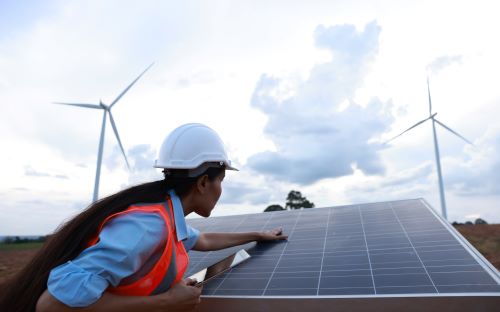Temperatures in India in February 2025 were the hottest since records began over a century ago, prompting warnings the country needs to urgently step up efforts to protect both workers and the general population from the health risks posed by extreme heat and humidity.
Features
Too hot to handle: early arrival of heatwaves in India sparks calls for action to protect workers and the public
The year 2024 was a chart-topper – India’s hottest since records began in 1901. Then came 2025. And the question on everyone’s mind in India is: how hot will it get?
February 2025 was the hottest in India in the last 125 years with the average mean temperature for the month standing at 22.04 degrees Celsius (°C), according to India Meteorological Department (IMD) data. The data also revealed that February 2025 was one of the driest with less than half the rainfall compared to other years.
“With 50.2 mm of cumulative rainfall, India saw 5th lowest rainfall since 2001 during February and 18th lowest since 1901,” states the IMD report.

Higher-than-usual temperatures
India is set to face higher-than-usual temperatures from April to June, with an increased number of heatwave days in central and eastern India and the north western plains, the weather department said. Most of the country will see above-normal maximum temperatures, with the exception of some regions in western and eastern India, where temperatures are expected to remain normal.
The town of Boudh in Odisha recorded 43.6°C on 16 March and Mumbai touched 38.7°C on 26 February – nearly six degrees Celsius above the normal.
Heatwave conditions led the Odisha and Maharashtra State Governments to announce that all school classes would start earlier in the morning in a bid to reduce the impact of the high temperatures on pupils’ health, wellbeing and performance levels.
Residents warned to take precautions
Meanwhile, as Karnataka braces itself for a hotter-than-usual summer, the state’s Health Department issued an advisory urging residents to take precautions against the rising heat and humidity.
The advisory recommends staying hydrated, wearing loose cotton clothes, using hats and umbrellas to avoid the glare of the sun and travelling during cooler times of the day. “Do not leave children or pets in parked vehicles. Temperatures inside a vehicle could get dangerous,” it adds.
The IMD has also forecast that north west India will experience almost twice as many heatwave days this summer season. Normally, the area sees about five to six heatwave days per season; however, this year, it is expected to encounter between 10 and 12 days.
In Delhi, the temperature soared to a blistering 40.5°C on 26 March. The last time Delhi experienced such high temperatures in March was in 2022, when it hit 39.1°C on 29 March.
With temperatures expected to rise by 1–3°C above average in the coming months, particularly in Delhi, potentially with severe consequences for human habitats, wildlife and the environment, the Parliamentary Standing Committee on Science and Technology, Environment, Forests and Climate Change has recommended that the central government’s Ministry of Environment, Forest and Climate Change (MoEFCC) designs and implements a national heat action plan to address the heatwave challenges citizens are likely to face this summer.
What is the definition of a heatwave?
The IMD defines a heatwave as a situation where the maximum temperature reaches 40°C in the plains, 30°C in hilly regions and 37°C in coastal areas, with a departure from the normal maximum temperature of at least 4 to 5°C. Additionally, a heatwave is declared when the temperature exceeds 45°C.
Climate experts warn that 2025 could be hotter than 2024 in India, signalling another year of severe climate changes.
Speaking to ETV Bharat digital national news platform, environmentalist and social justice campaigner Manu Singh described the early heatwaves coupled with rising night-time temperatures as a direct and alarming indicator of anthropogenic climate change. “Notably, India recorded its first-ever winter heatwave on 25 February, affecting Goa and Maharashtra, a phenomenon previously unheard of in India’s historical climate records,” he said.
Singh added that the observed fluctuations in March temperatures in Delhi over recent years reflect complex interactions between atmospheric dynamics, urbanisation effects and broader climate change trends.
In 2024, India experienced the longest-ever heatwave in its recorded history with 536 heatwave days in various locations across the country, and the forecasts for the future are alarming. Action is overdue, say health and climate experts.
Human toll of heatwaves
The human toll of last summer’s heatwave was catastrophic: between 1 March 1 and 20 June, the Union Ministry of Health reported 143 deaths and 41,789 suspected cases of heatstroke across the country. The most affected were the poor, living in ill-ventilated homes without cooling systems. Street vendors, who work outdoors for nearly 12 hours a day on average, were especially at risk, facing dehydration, heat exhaustion, and potentially fatal heat strokes. A Greenpeace India-National Hawkers Federation survey of 721 street vendors in Delhi, conducted between April and May last year, highlighted their particular vulnerability to the harmful health effects of high temperatures and rising humidity.
According to the Sixth Assessment Report of the Intergovernmental Panel on Climate Change (IPCC), a United Nations body that seeks to assess and advance scientific knowledge about climate change, human-caused climate change has increased the frequency and intensity of heatwaves since the 1950s and additional warming will further increase their frequency and intensity.
The 2023 report also found that highly vulnerable groups likely to experience health impacts from heat stress include anyone working outdoors and especially those doing outdoor manual labour, such as construction and agricultural work.
“Climate change is exacerbating the frequency and severity of such events, profoundly impacting societies, economies and, most importantly, human lives and the environment that we live in,” World Meteorological Organisation (WMO) deputy secretary-general Ko Barrett told the 80th session of the Economic and Social Commission for Asia and the Pacific last year.
Ko Barrett emphasised that the extreme weather events in Asia in 2024 are a continuation of the trends outlined in the WMO State of the Climate in Asia 2023 report. The report revealed that Asia remained the most disaster-prone region for extreme weather events globally in 2023, facing the highest number of casualties and economic losses from weather, climate and water-related hazards. Floods and storms were the primary contributors to these impacts, while the severity of heatwaves intensified.
Extreme heat is increasingly becoming the big silent killer, added Ko Barrett.
“April is typically a hotter month in the south Asia and south east Asia regions, but El Nino and climate change are driving temperatures to precariously high levels,” stated Ben Churchill, director of the WMO’s Regional Office for Asia and the South-West Pacific.
Inadequate long-term strategies
Although India has been rolling out integrated heat-health forecast action plans and #BeatTheHeat campaigns, particularly promoted by organisations like the United Nations Development Programme, a new report by the Sustainable Futures Collaborative (SFC), a New Delhi-based research organisation, found that Indian cities’ heat action plans (HAPs) lack long-term strategies to tackle the growing threat of extreme temperatures and humidity. It concluded that the solutions being implemented are generally short term and weakly targeted – posing a major threat to the ability of communities to adapt to the future climate.
The study was authored by researchers from SFC, King’s College London (England), Harvard University (USA), Princeton University (USA) and the University of California (USA).
The researchers argue that while India’s current actions on extreme heat focus on the immediate survival of vulnerable members of the population, there is an urgent need to begin preparing for the deadly climate extremes of the future.
The study examined the implementation of heat action plans (HAPs) in nine cities across nine states with extremely high future heat risks, representing 11 per cent of India’s urban population. It aimed to assess how government officials at the city, district and state levels – responsible for heat-related actions across various departments – are addressing current and future heat challenges.
The nine cities were selected because they are expected to see some of the largest increases in dangerous heat under 1.5°C of warming compared to a 2013–22 baseline.
Key findings
The study’s key findings include:
- Short-term or emergency measures, such as setting up water stations, adjusting school and work hours, opening cooling centres and repurposing hospital wards for the treatment of heatstroke patients, are in place to an extent. However, long-term plans to increase the cities’ resilience to heat are either absent or poorly executed, such as insufficient large-scale tree planting to provide shade and reduce the impact of the sun on ground level temperatures.
- There is limited coordination between city departments, with many city planners unaware of the severity of heat risks.
For example, although Mumbai has some programmes aimed at boosting community awareness of the health dangers of heatwaves and how to mitigate them, the SFC says the city lacks a comprehensive city-wide HAP.
In Delhi, certain state government departments are prepared for the expected sustained increase in temperatures, but there is no centralised strategy to link them, warns the SFC report. In addition, cities like Kota and Gwalior face significant resource limitations, reducing their ability to plan for and cope with the health and other impacts of heatwaves, adds SFC.
Focus on preparing healthcare systems for heatwaves
Writing for the Carbon Brief website, researchers from SFC and other universities involved in the study said that the cities’ long-term measures designed to increase heat resilience largely focused on health system preparedness actions, such as healthcare staff training, aimed at avoiding the consequences of heat overwhelming the adaptive capacity of society. However, they warned that the cities studied are much less likely to implement long-term actions that can be implemented now to reduce future heat risk in these cities, such as large-scale tree planting.
The SFC researchers added: “Long-term heat intentional actions that sit outside the health system – which are typically designed to prevent society’s adaptive capacity from being overwhelmed in the first place – were less common in cities studied. A picture of very weak mainstreaming of long-term heat actions emerges when health system preparedness is excluded from the analysis.
“The study also finds that many actions with potential long-term benefits – which includes the expansion of urban shade and green cover, the creation of open spaces that dissipate heat and the deployment of rooftop solar that can power building cooling systems – were being implemented as a part of routine developmental policy, with few direct links to heat concerns.
“These actions… are not specifically targeted at the most heat-vulnerable areas of the cities studied. As a result, they could have weak and inconsistent effects on heat resilience.
“The execution of these long-term incidental actions undoubtedly contributes to adaptive capacity for dealing with heat. However, the fact they are not explicitly designed to also address extreme heat is a missed opportunity.”
“In eight of the nine cities, for example, trees planted were not aligned with heat vulnerability assessments. Officials in multiple cities reported challenges to planting trees in dense, hot slums and informal settlements, where land is scarce and politically fraught.
“Meanwhile, some key long-term measures are entirely missing, including: insurance for lost working hours lost, which is crucial as heat chips away at productivity; electricity grid retrofits that can meet the rising electricity demand from cooling; and cooling access for the most vulnerable.”
‘Inconsistent and weakly targeted’ long-term heat actions
The SFC researchers added: “India’s heat plans have proliferated rapidly at multiple levels of government, but are generally neither backed by law or finance, giving them little purchase in already-stretched local governments.
“The distribution of inconsistent and weakly targeted long-term heat actions in our sample suggests that India will likely see more frequent heatwaves with higher mortality levels in the coming years.
“In other words, the lack of these actions could see communities’ adaptive capacities overwhelmed by rising temperatures.”
Meanwhile, in 2013 Ahmedabad city introduced South Asia’s first HAP designed to mitigate the health risks of extreme heat for vulnerable members of the population. The HAP focuses on key areas such as:
- Raising public awareness and engaging with communities
- Establishing an early warning system and fostering inter-agency collaboration
- Enhancing the capacity of healthcare professionals
- Minimising heat exposure and promoting adaptive strategies.
However, climate experts argue that similar HAPs in other cities are often more advisory in nature, lacking strong enforcement and implementation measures.
For instance, commentators point to the example of the National Disaster Management Authority (NDMA). The NDMA, in collaboration with states and the IMD, created HAPs for 23 states and union territories. But in most of the states, such plans remain largely on paper, say commentators.
In fact, analysis by India’s Centre for Policy Research (CPR) of 37 HAPs – nine at the city level, 13 at the district level, and 15 at the state level across 18 states – indicates that most are ineffective in identifying and addressing vulnerable groups. Many of these plans were not tailored to local contexts and presented an overly simplified understanding of the heat hazard, says the CPR.
Practical measures
In their comment article for the Carbon Brief website, researchers from SFC argued that practical measures could be taken to build heat resilience in Indian cities – which would in turn help protect the health of both the general population and workers, particularly those working outdoors, who face the greatest health risk from high temperatures.
“Embedding long-term resilience for extreme heat and other climate hazards in legal structures, alongside appropriate financial backing, could improve accountability and the monitoring of solutions,” they wrote. “This could involve updating climate and disaster management legislation to make implementation of extreme heat actions mandatory.
“Meanwhile, many of the most commonly reported problems… could be tackled with sustained capacity building in local government. This could include a combination of new positions dedicated to extreme heat and staff training on appropriate resilience measures.
“Adequately staffed, financed and trained local government officials are more likely to coordinate with each other, deal with simultaneous and competing priorities and understand the urgency
of implementing long-term actions.
“In addition, making crucial climate information available to government officials tasked with designing and implementing heat measures could result in a more targeted response.
“This could include regional climate model output that provides projections on what the most dangerous days of heat will look like in the hottest parts of cities – and vulnerability assessments and urban heat island maps showing spatial variation in impacts.”
The SCP researchers concluded: “Adapting to increasing extreme heat will be central to urban living for decades to come. A late start to these efforts will increase pressure on the state in the future and risks exposing citizens to harms from warming that could be avoided.”


FEATURES

India’s path to net zero: a work in progress
By Orchie Bandyopadhyay on 08 April 2025
India is implementing a variety of clean energy measures to hit its target of net zero greenhouse gas emissions by 2070, including plans to rapidly scale up the generation of nuclear power. However, climate experts say significant finance will be required from developed countries to phase out coal power, accelerate renewables deployment and expand the national electricity grid.

Too hot to handle: early arrival of heatwaves in India sparks calls for action to protect workers and the public
By Orchie Bandyopadhyay on 08 April 2025
Temperatures in India in February 2025 were the hottest since records began over a century ago, prompting warnings the country needs to urgently step up efforts to protect both workers and the general population from the health risks posed by extreme heat and humidity.

